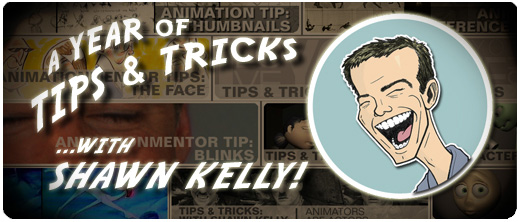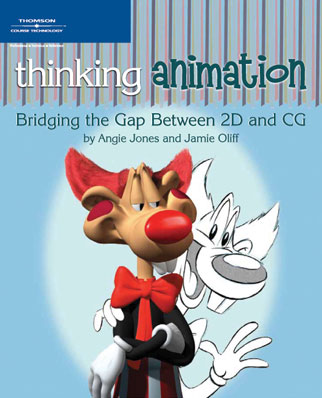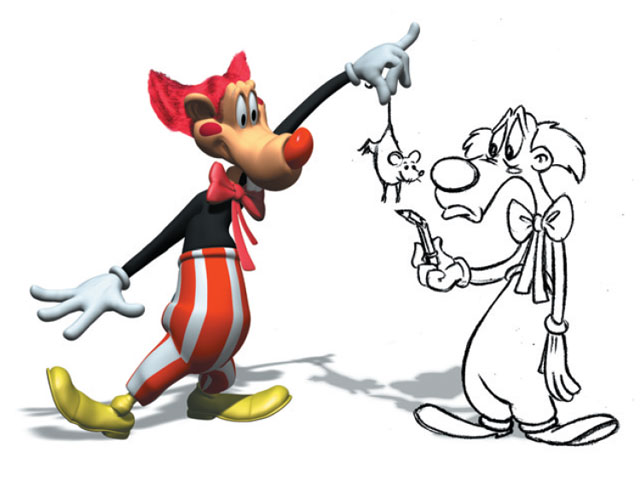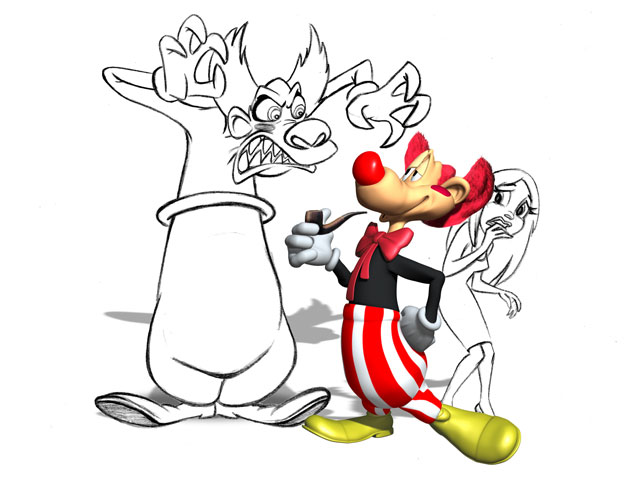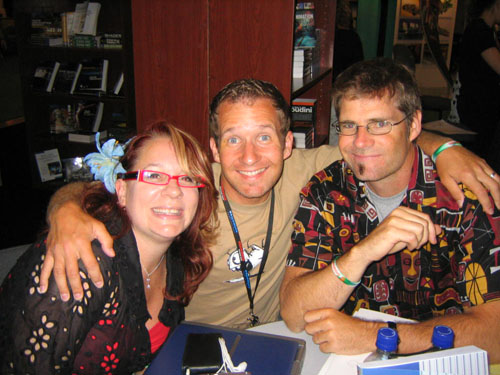Well, guess what time it is?
It's time to celebrate!! That's right, this is the one year anniversary of our famously rambling tips & tricks article!
A year ago I thought this was going to be a three part article about planning your scenes... Knowing my tendency to ramble, one of the fellas at work said he doubted that I could keep my "planning article" to a mere three parts. Well, here I am a year later, still rambling on and on about all things animation, so I guess he was right!
Anyway, I've been having a lot of fun writing it, and even more fun hearing back from you guys (hit me at: tipsandtricks@animationmentor.com), so it's time to sit back, reflect on a year of tips, and most of all - to celebrate! I warned you that I'd be mowing down on fried chicken and drinking a celebratory Bacardi Anejo y coca (that's aged Bacardi, which tastes approximately 1000 times better than regular Bacardi, and Coke), so that's exactly what I'm doing!
In light of that, I should probably try to write fast, because if I start to get tipsy, there's no telling how long this article might get, or what bizarre tangency we might find ourselves pulled down... I can only guarantee true animation talk for 2 drinks, at most. If I hit drink #3 and we're still all sitting here, there's a very real danger that we'll start talking about a lot less about animation and a lot more about fried chicken, why I hate moths, and the dream I had last week where undercover agents were attacking me with angry attack chickens...
Anyway, if you're of drinking age and want to join in with me for my One Year Anniversary celebration, you'll need the following:
A glass.
5 pieces of ice.
1/2 can of Pepsi (or Coke, if you think Coke tastes better than Pepsi, but you're wrong)
1 1/2 shots of Bacardi Anejo (or a little more, if you're feeling especially macho)
Mix all of those things together, and prepare for some tasty goodness!
So... First off, I want to address a few comments I got in the email last month:
I heard some great tips about removing permanent maker ink from your monitor (where were you guys when I needed you!?!), so while I have no idea if these ideas actually work, if you find yourself with ink on your monitor (as I did), you could take Yudhatama's advice and try paint thinner to remove it... Or you could listen to Chad T, who found that going over his permanent marker mistake with a dry erase marker made the
ink erasable! (Great tips! Thanks!)
Someone also pointed out that I should have elaborated more about using dry-erase markers on an LCD monitor. If you don't want to draw directly on your monitor (which isn't the greatest thing for your LCD monitor, potentially), some people get a hold of a piece of plastic, or Mylar, or a clear animation cell and attach it to their monitor with tape. When they want to draw, the simply flip the cell down in front of their monitor, track their arcs, fix their work, and then flip the cell back over their monitor. (Thanks to Jeff G for this great idea!)
And since we're in reader-feedback mode, I had a request from Jessica Duenke to send out a visual example of my bell-pull description from last month (which she kindly neglected to mention was the most confusing description of an animation example in the history of animation examples). In case you are a new reader, or (more likely) your horrified brain immediately rejected and erased the memory last month, I was talking about the spiraling motion of the hips generating all of the power in a "bell-pull" example.
I dug around through my notebooks, and happened to see an old quickie sketch I had done for some students in a class once when we were talking about something really similar, so I went ahead and scanned it in.
While this was a very quick drawing done on the spot, it's actually pretty exemplary of the extent of my drawing skills these days, so in case you've been harboring any illusions that you're reading a tips & tricks article written by someone who can draw like James Baxter, prepare for immediate and sobering disappointment.
Shawn Kelly’s bell-pull example:
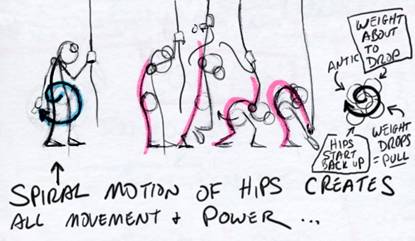
...Okay, for those of you who didn't immediately close the newsletter in disgust, the blue line is the exaggerated spiraling path of the hips I was talking about tracking the arc of, some of which is roughly broken down on the far right as well. Obviously this is only one of a gajillion ways to animate a bell-pull, but it was a way to illustrate my point. (James Baxter did an amazing bell-pull at the beginning of Hunchback of Notre Dame that's worth frame-by-framing, by the way. (Awesome example of force).
Anyway, that was a pretty awesome drawing, huh? Check out how when he stretches up onto his toes, he's the exact same height as when he's standing there hunched over. Talk about volumes being all out of whack... Yikes! And those circles at the top of his arms are supposed to indicate shoulders, by the way... ugh.
Wow. Looking at it now, it's really....embarrassing. I'm so tempted to delete this, but I'm way too lazy to redraw it properly... Hang on a minute, time to refill Mr. Bacardi Anejo before I get too depressed.
Okay, I'm back and feeling much better! Mr. Bacardi Anejo was just telling me that it's "okee dokee artichokee" not to redraw the abomination you see above, and is helping me justify my laziness by claiming that I'll have more time to write if I don't spend time redoing an old drawing... Wow, cool! Thanks, Mr. Bacardi Anejo! You're such a swell Anejo! (even if you do use words like "artichokee...")
(uh oh, drink #2 is showing, huh? I'm pretty sure that when you're having a conversation with your drink in front of around 18,000 people, you're officially tipsy).
Anyway, what I had written last month was the following, and hopefully it might make more sense now, unless the drawing is so horrible that I've confused you even further. (If so, then I apologize, but respectfully blame the combined efforts of Jessica and Bacardi Anejo).
===============================================
"Let's say my character is going to ring a bell by pulling down on a rope. Through planning my scene, I've discovered that all of the force the character is going to use to pull on that rope is through a wave action that moves from the hips, through the spine, and finally out into the arms, and that wave action is caused by a clockwise outwardly-spiraling arc of the hips.
Wow, was that confusing? I wonder if I could possibly have chosen a more complicated example for this... jeez. Well, it's too late now, folks. We're in too deep. See, we're already two paragraphs into this example, and I haven't eaten dinner yet (nope, not fried chicken tonight... I wish!), so there's no way I'm going back now! We'll just keep slogging through the bell-pull. Trust me, we can do it...
Anyway, the hips move in a clockwise spiraling arc that goes like
this: They move back and down a bit, then up, then forward, then down and forward, and then down and back, and then start to move up and back."
===============================================
Does that make any more sense now that you've seen my masterpiece drawing? Hope so!
Okay, so this month's article is getting pretty heavy on reader-feedback. I think I'd better turn it into an all-reader-feedback article! Otherwise we're all going to be sitting here for a VERY long time, and longtime readers know that when I say "very long time," I mean "it's going to take you more than one day to read this."
So let's do a little more reader feedback, drink the rest of our Bacardi Anejos, and do our best to forget about Shawn Kelly's drawing abilities (or lack thereof)...
A bunch of you have been asking about older Tips & Tricks articles.
These do still exist if you're clever enough to find them (play with the dates in the html address at the top of your browser), but we're going to go ahead and start linking into an archive for ya, so that'll be on the way soon.
I got a couple emails asking about figure 8 arcs, which I had considered writing about tonight, but I think it'll have to wait for an upcoming article since we're rapidly approaching Drink #3, and we all know what happens then...
...Angry Attack Chickens. Need I say more?
Let's see... what else?
Someone asked me if I'm working on a personal project -- yup, it's called Animation Mentor!
I also got a couple of questions from people just getting into animation (woo hoo!) curious as to what my "most important tip" would be for them. Once we get the archived articles up and running, check out the first few, which are all about planning. My biggest tip would be to not rush into animation. To spend the appropriate amount of time planning your shot, and really thinking through every aspect of it *BEFORE* you sit down in front of your computer, drawing disc, or puppet.
The best advice I was ever given was when Steve Williams (of Jurassic Park fame) visited our school and said, "If you want to become an animator, take your computer and bury it in the backyard. Then learn how to animate. Then go dig up your computer and start using it as your tool."
That advice changed my life in a very real way, and I know that without hearing that from professionals, I would have continued down the path of learning tools and technology instead of the art of animation. It really drove home the idea that animation is a craft, independent of whatever tool you happen to be using at the time.
It was shortly after that that Wayne Gilbert sat me down and explained scene planning in a way I had never heard discussed before, and once again, it was all about the work you do before you sit down in front of your tool. His advice was that the more time you spend planning, the better your shot will turn out, and the easier it will be to animate.
Those two pieces of advice ("it's the art, not the tool," and "PLAN your
work!") are easily the best two pieces of animation advice I've ever received, and would always be my "most important tips" to pass along to anyone diving into the world of animation!
Okay, that's all I've got. Drink #2 is gone, so unless you want to start hearing about why moths are evil or Angry Attack Chickens, I think we should call this article finished! (Wait, that's actually not a bad idea for a short film! Angry Attack Chickens vs. Evil Moths! Yeah!! ...Wait. Oh. Okay, yeah, that's a horrible idea. ...Never mind. See what I'm talking about? I better end this one FAST or we're in serious trouble...)
Before we wrap up the year, I have to give an extra-special thanks to the endlessly patient Monique Shih, who has graciously agreed to help edit these things for me and patiently puts up with my rambling articles, and a big thanks to all of YOU for reading! It's been a lot of fun writing this all year, and even more fun hearing back from you!
Next month it'll be business as usual, with a no-alcohol policy, and some honest-to-goodness animation advice!
See ya next time! Happy One Year to all of us!
Keep animating, and, as always... have FUN!
- shawn :)


